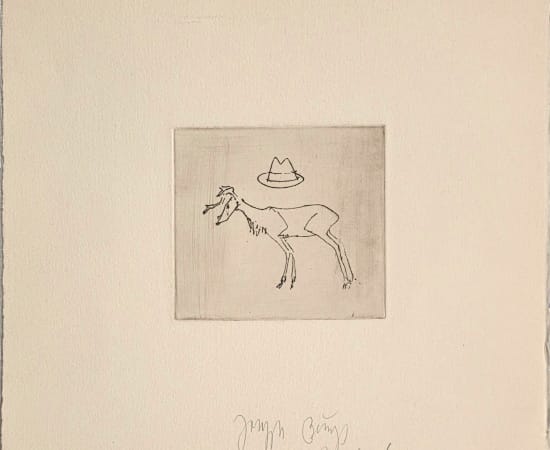Joseph Beuys Germany, 1921-1986
Joseph Beuys was one of the most influential and provocative artists of the 20th century, whose work radically expanded the definition and function of art in society. Born in Krefeld, Germany, in 1921, and raised in the industrial town of Kleve, Beuys experienced the trauma of war firsthand. As a Luftwaffe pilot during World War II, he was shot down over Crimea in 1944—a formative event that later became central to the myth-making that surrounded his life and work. He claimed to have been rescued and cared for by nomadic Tartars who treated his wounds with animal fat and felt—materials that would become symbolic elements in his practice.
After the war, Beuys enrolled at the Kunstakademie Düsseldorf, where he later became a professor. It was during the 1960s that he emerged as a major figure in the international avant-garde, particularly through his involvement with the Fluxus movement. He pioneered the genre of performance art, or what he called “actions,” merging physical, symbolic, and philosophical gestures in works that questioned the role of the artist and the boundaries of art itself. Notable performances such as How to Explain Pictures to a Dead Hare (1965) and I Like America and America Likes Me (1974) were powerful meditations on communication, ritual, and healing.
Beuys is perhaps most widely known for his theory of “social sculpture”—the idea that art is not confined to objects or galleries but is a means of shaping society. He believed that every person is an artist, capable of contributing creatively to the transformation of political and cultural life. This radical view of art as a democratic, participatory process influenced generations of artists, thinkers, and activists.
A passionate educator and activist, Beuys co-founded the Free International University for Creativity and Interdisciplinary Research in 1973, and was a founding member of the German Green Party. His work often addressed ecological and political themes, advocating for direct democracy, education reform, and environmental stewardship.
Throughout his career, Beuys blurred the lines between art, politics, and life. His installations, performances, drawings, and teachings continue to resonate, inspiring contemporary discourse on the role of art in society. Beuys died in Düsseldorf in 1986, but his legacy endures as a visionary who redefined what it means to be an artist.






